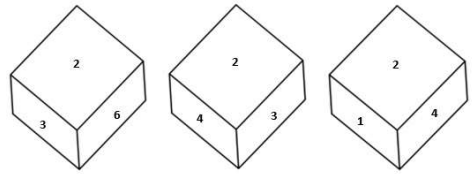Reasoning Practice Question and Answer
8 Q:Which of the following numbers will replace the question mark (?) in the given series?
26, 54, 110, 222, ?, 894
733 064abeceb299b7896000b76fb
64abeceb299b7896000b76fb- 1446true
- 2442false
- 3440false
- 4444false
- Show Answer
- Workspace
- SingleChoice
Answer : 1. "446"
Q: Three different positions of the same dice are shown. Find the number on the face opposite to the face showing'3'.

957 064abec84b394764d11c79451
64abec84b394764d11c79451
- 15false
- 22false
- 31true
- 46false
- Show Answer
- Workspace
- SingleChoice
Answer : 3. "1"
Q: A question is given, followed by two statements numbered (I) and (II). You have to decide whether the data provided in the statements is sufficient to answer the question. Read both statements and select the appropriate answer. Question: A, B, C and D are sitting around a circular table facing the centre. Who sits to the immediate right of A?
Statements:
(I) C sits to the immediate left of A; only one person sits between C and D.
(II) Only one person sits between A and B; C sits to the immediate right of B.
767 064abeb639a74b54cff6d9fe9
64abeb639a74b54cff6d9fe9(I) C sits to the immediate left of A; only one person sits between C and D.
(II) Only one person sits between A and B; C sits to the immediate right of B.
- 1Data in statement I alone is sufficient to answer the question while data in statement II is notfalse
- 2Data in either statement I alone or statement II alone is sufficient to answer the questiontrue
- 3Data in statements I and II together is sufficient to answer the questionfalse
- 4Data in statement II alone is sufficient to answer the question while data in statement I is notfalse
- Show Answer
- Workspace
- SingleChoice
Answer : 2. "Data in either statement I alone or statement II alone is sufficient to answer the question"
Q:In the following question below are given some statements followed by some conclusions based on those statements. Taking the given statements to be true even if they seem to be at variance from commonly known facts. Read all the conclusions and then decide which of the given conclusion logically follows the given statements.
Statements:
I. All pencil are pen.
II. Some pen are rubber.
Conclusion:
I. All rubber are pencil.
II. Some pen are not pencil.
III. Some rubber are not pen.
543 064abea3af9f3b582590260f3
64abea3af9f3b582590260f3I. All pencil are pen.
II. Some pen are rubber.
I. All rubber are pencil.
II. Some pen are not pencil.
III. Some rubber are not pen.
- 1Neither conclusion followstrue
- 2Only conclusion II followsfalse
- 3Both conclusions I and III followsfalse
- 4All conclusion followsfalse
- Show Answer
- Workspace
- SingleChoice
Answer : 1. "Neither conclusion follows"
Q: In a certain code language, 'LAPTOP' is written as ‘JYNRMN’ and ‘COLD’ is written as ‘AMJB’, how will 'SKETCHPEN' be written in that language?
846 064abe9b79a74b54cff6d7924
64abe9b79a74b54cff6d7924- 1RJDSBHODMfalse
- 2QICRBHODMfalse
- 3QICRAFNCLtrue
- 4RJDSAFNCLfalse
- Show Answer
- Workspace
- SingleChoice
Answer : 3. "QICRAFNCL"
Q:Select the set in which the numbers are related in the same way as are the numbers of the following sets. (NOTE: Operations should be performed on the whole numbers, without breaking down the numbers into its constituent digits. E. g. 13 – Operations on 13 such as adding / subtracting / multiplying etc. to 13 can be performed. Breaking down 13 into 1 and 3 and then performing mathematical operations on 1 and 3 is not allowed)
(26, 120, 34)
(14, 110, 41)
903 064abe9719a74b54cff6d78b0
64abe9719a74b54cff6d78b0(14, 110, 41)
- 1(36, 106, 17)true
- 2(72, 240, 16)false
- 3(44, 114, 24)false
- 4(15, 450, 8)false
- Show Answer
- Workspace
- SingleChoice
Answer : 1. "(36, 106, 17)"
Q: By interchanging the given two signs and numbers which of the following equation will be correct?
× and +, 6 and 4
413 064abe8ca8c254a4ceae3781d
64abe8ca8c254a4ceae3781d× and +, 6 and 4
- 13 × 9 – 4 ÷ 2 + 6 = 8false
- 28 × 6 + 4 ÷ 2 – 5 = –5false
- 38 – 3 × 6 + 4 ÷ 1 = 18false
- 47 × 6 – 4 + 9 ÷ 3 = –7true
- Show Answer
- Workspace
- SingleChoice
Answer : 4. "7 × 6 – 4 + 9 ÷ 3 = –7"
Q: A situation is given, followed by two conclusions I and II. Read the situation and both the conclusions carefully and select the correct answer.
Situation: Since the past 15 years, 75% of the products in the world’s pottery market comes from Country K. However, the employment in the pottery industry of Country K has been consistently declining by 5-9% every year since the past 3 years.
Conclusions:
I. Even after declining employment, Country K has enough potters to continue contributing equally to the international market.
II. The local demand of pottery in Country K has substantially decreased leading to less interest among potters. 1618 0649ec85a1a612ce00104e061
649ec85a1a612ce00104e061Situation: Since the past 15 years, 75% of the products in the world’s pottery market comes from Country K. However, the employment in the pottery industry of Country K has been consistently declining by 5-9% every year since the past 3 years.
- 1Neither I nor II can be concludedfalse
- 2Only II can be concludedfalse
- 3Only I can be concludedtrue
- 4Both I and II can be concludedfalse
- Show Answer
- Workspace
- SingleChoice

